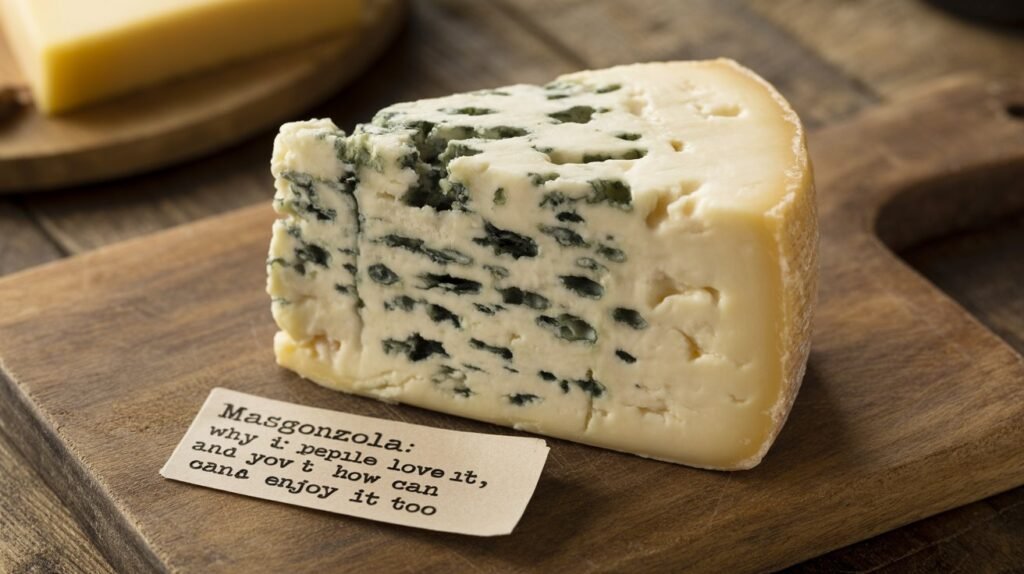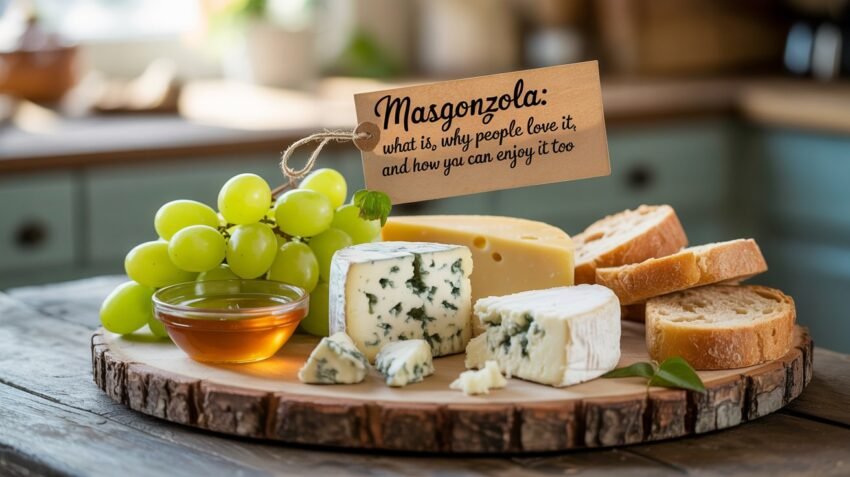Table of Contents
Introduction
Have you ever tasted something so rich, creamy, and packed with flavor that you had to know what it was? That, my friend, might have been masgonzola. Whether you’re a food lover, a home cook, or someone who just enjoys trying new things, this delicious cheese blend will win you over in no time.
Masgonzola isn’t just a fun word—it’s a mix of mascarpone and gorgonzola, two delicious Italian cheeses. When combined, they create a soft, creamy, slightly tangy cheese spread that’s perfect for many dishes. It’s smooth, flavorful, and super versatile.
In this easy-to-understand guide, we’ll talk about what masgonzola is, how it’s made, where you can use it, and why it might just become your new favorite kitchen staple. Whether you’re spreading it on bread, stirring it into pasta, or using it as a dip, there’s a lot to love.
Let’s take a closer look at the world of masgonzola and discover how it can bring creamy, cheesy joy to your plate.
What Is Masgonzola? A Simple Explanation
Let’s start with the basics: Masgonzola is a mix of two cheeses—mascarpone and gorgonzola. When blended together, they create a creamy, tangy cheese spread that’s softer than cream cheese and bolder than brie.
Mascarpone is a mild, sweet, buttery cheese. Gorgonzola is an Italian blue cheese with a sharp, tangy flavor. On their own, they’re both amazing. Together? They become something magical.
Masgonzola is often spread on crackers, used in pasta sauces, added to pizzas, or even mixed into dips. Its rich texture and balanced taste mean you can use it in sweet or savory dishes.
It’s perfect for anyone who wants a cheese that’s creamy but not boring, bold but not overpowering. It’s a flavor that works in almost everything—once you try it, you’ll wonder where it’s been all your life.
Where Did Masgonzola Come From?
Unlike many traditional cheeses traced back centuries, masgonzola isn’t an old-world invention. It’s a modern fusion born from smart food lovers combining the best of two worlds.
Mascarpone has its roots in northern Italy, often used in desserts like tiramisu. Gorgonzola, also Italian, dates back over a thousand years and is known for its blue veins and tangy bite.
By blending the creamy, mild taste of mascarpone with the punchy, flavorful gorgonzola, chefs created this delightful combo cheese. It has rapidly gained popularity in upscale kitchens and home recipes alike.
Even though masgonzola is not officially recognized as a type of cheese like cheddar or mozzarella, it has found a place in the hearts (and fridges) of many food fans all over the world.
What Makes Masgonzola So Special?
There are many cheeses to choose from. So what makes masgonzola stand out?
First, it’s all about texture. Masgonzola is luxuriously smooth. You can spread it with ease or melt it into sauces. It covers your tongue with a rich, creamy blanket that leaves both sweet and tangy notes behind.
Next, it’s the balance. Some cheeses are too strong for some people. Gorgonzola can be intense on its own. Mascarpone can be mild. Put them together, and you get a perfect, creamy cheese that’s delicious but not overpowering.
Finally, it’s the versatility. You can use masgonzola in appetizers, main dishes, soups, or desserts. Few cheeses work in as many different ways.
In short, masgonzola is special because it’s more than a cheese—it’s a kitchen hero in disguise.
How to Use Masgonzola in the Kitchen
Now for the fun part—cooking with masgonzola. Whether you’re a home chef or just learning how to boil pasta, this cheese can turn simple meals into something memorable.
Here are a few popular ways to use it:
- Pasta Sauces: Stir it into hot noodles with a little pasta water and black pepper for a super creamy meal.
- Pizza: Dollop it on top after baking for a rich, melty topping.
- Steak or Chicken: Melt it over grilled meats for that fancy finish.
- Dips: Combine with herbs and sour cream for a bold dip.
- Cheese Boards: Spread it on crackers with honey or figs.
- Stuffed Veggies: Fill peppers or mushrooms with it and bake.
Its creamy nature means you don’t need to do much. A spoonful of masgonzola goes a long way in adding flavor.
Masgonzola vs. Other Cheeses
Let’s compare masgonzola to other popular cheeses so you can really see how it stands out.
- Cream Cheese: Similar texture, but masgonzola has more flavor and depth.
- Brie: Both are creamy, but masgonzola is smoother and has a stronger taste.
- Blue Cheese: Masgonzola is milder and more spreadable, great for people who find blue cheese too strong.
- Goat Cheese: Both are tangy, but masgonzola is silkier and less crumbly.
In short, if you like cheeses that sit between strong and mild, smooth and sharp, masgonzola is the perfect middle ground.
Where to Buy Masgonzola
Masgonzola is becoming more common in stores, especially near the specialty cheeses. Look for it in the refrigerated section, often in tubs or small cartons.
You’re likely to find it at stores like:
- Whole Foods
- Trader Joe’s
- Local Italian delis
- Gourmet cheese shops
- Some large-chain grocery stores with deli counters
You can also buy masgonzola online, with many outlets offering chilled shipping with ice packs. Just make sure the label mentions both mascarpone and gorgonzola in the ingredients—some brands will market it under different names.
Can You Make Masgonzola at Home?
Yes, you can! In fact, making homemade masgonzola is super easy and only takes a couple of minutes.
Here’s a basic recipe:
Ingredients:
- 4 oz gorgonzola cheese (crumbled)
- 8 oz mascarpone cheese (softened)
- Pinch of salt (optional)
Steps:
- Let the cheeses sit at room temperature for about 15 minutes.
- Mix both together in a bowl using a fork or hand mixer.
- Taste and adjust—add more mascarpone if you want it milder.
- Store in the fridge for up to a week.
It’s that simple! And once you’ve made it once, you can adjust it however you like.
Is Masgonzola Healthy?
Cheese can be part of a healthy diet when enjoyed in moderation, and masgonzola is no different.

Here are some basic nutrition facts (per 2 tbsp serving, approx.):
- Calories: ~120
- Fat: ~10g
- Protein: ~3g
- Calcium: Good source
- Carbs: Low
Because it’s rich and flavorful, you don’t need much to enjoy it. A tablespoon or two can elevate a dish without overdoing it.
That said, masgonzola is still a full-fat cheese, so it’s best used as a treat or as part of balanced meals.
Kid-Friendly Ways to Enjoy Masgonzola
Not everyone thinks kids will like something with “gorgonzola” in it—but you might be surprised!
Try these fun, gentle ways to introduce masgonzola to younger eaters:
- Spread it on toast with a drizzle of honey
- Mix into mashed potatoes
- Use in cheesy pasta instead of cheddar
- Serve as a veggie dip with carrots and crackers
When blended with other kid-friendly ingredients, the strong blue cheese taste fades just enough so kids notice the creamy delight before the tangy finish.
How to Store Masgonzola Properly
Keep masgonzola refrigerated at all times. Once opened, put it in a small airtight container to keep it from drying out.
Tips for storage:
- Refrigerate after every use
- Use within 5 to 7 days for best taste
- Do not freeze—it changes the texture
- Stir well before serving if separation occurs
If it begins to smell sour in a bad way or mold appears (other than its natural blue veins), it’s time to toss it out.
FAQs
1. What does masgonzola taste like?
It’s creamy and rich like mascarpone, with a slightly tangy blue cheese bite from the gorgonzola.
2. Is masgonzola the same as blue cheese?
Not quite. Blue cheese is usually stronger. Masgonzola is milder and creamier due to the mix with mascarpone.
3. Can I cook with masgonzola?
Yes! It melts well. Use it in pasta, sauces, soups, or even on top of steak.
4. Where can I buy masgonzola cheese?
Check gourmet groceries, cheese shops, or Italian delis. You can also make it at home.
5. How long does masgonzola last after opening?
It lasts about 5-7 days in the fridge when sealed and stored properly.
6. Can I freeze masgonzola?
Freezing is not recommended, as it can ruin the smooth texture when defrosted.
Conclusion
Whether you’re a cheese lover or just dipping your toe into the world of gourmet foods, masgonzola is a must-try. It’s creamy, flavorful, and easy to use in everyday meals.
From pasta dishes to party dips, this Italian fusion cheese adds a touch of richness that makes everything more enjoyable. And the best part? You don’t have to be a chef to work with it. A spoonful here and there can completely transform your plate.
